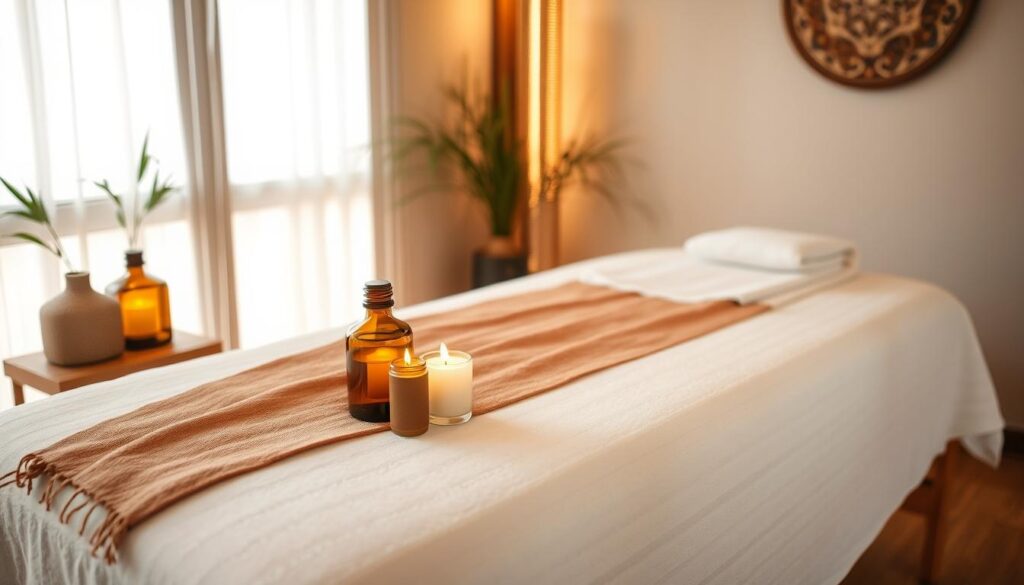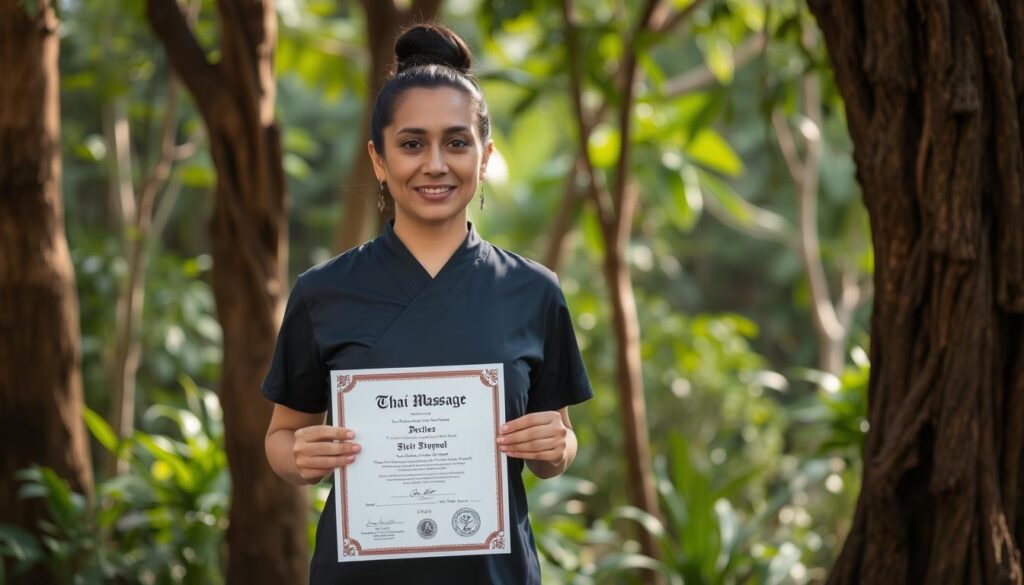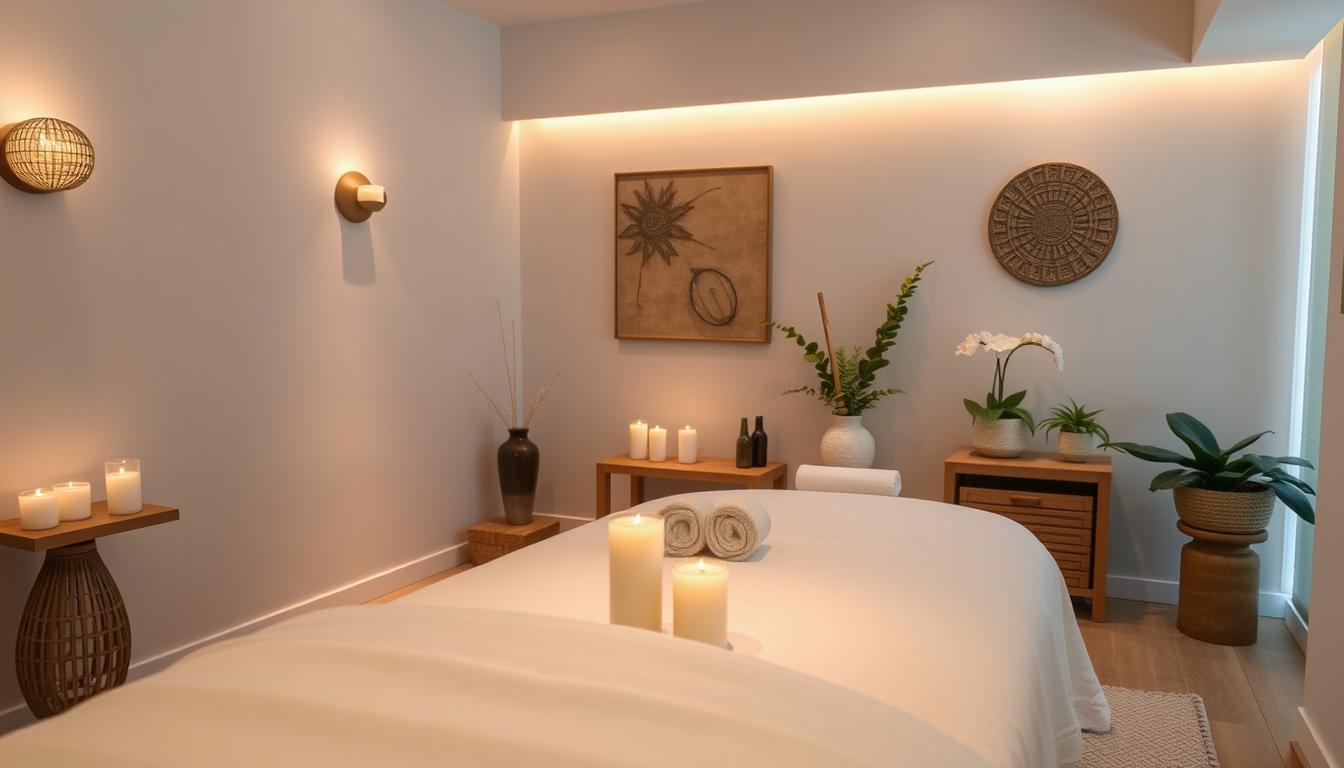Thai massage is an ancient healing therapy over 2,500 years old. It combines assisted stretching, acupressure, and rhythmic compression. This helps relieve tension, improve flexibility, and restore balance to the body.
This unique massage is done fully clothed on a floor mat. It doesn’t use oils, unlike traditional Western massages.
If you’re thinking about trying thai massage for the first time, you might have questions. This article will guide you through its history, benefits, and techniques. It also answers common questions about massage therapy.
Introduction to Thai Massage
Thai massage is a holistic approach to health and wellness. It combines physical movement with mental and emotional balance. By understanding thai massage, you can enjoy its many benefits.
These benefits include relief from stress and tension, improved flexibility, and enhanced overall well-being. Regular massage therapy sessions can help you achieve these benefits.
Key Takeaways
- Thai massage is a 2,500-year-old healing therapy that combines assisted stretching, acupressure, and rhythmic compression.
- Thai massage is performed fully clothed on a floor mat, without the use of oils.
- Thai massage aims to relieve tension, improve flexibility, and restore balance to the body.
- Thai massage is a holistic approach to health and wellness, combining physical movement with mental and emotional balance.
- Regular thai massage sessions can provide relief from stress and tension, improved flexibility, and enhanced overall well-being through massage therapy.
Understanding the Ancient Art of Thai Massage
Thai massage has a long and interesting history. It comes from ancient healing practices that go back thousands of years. This history is tied to Thailand’s spiritual and cultural roots, influenced by Buddhism, Ayurveda, and traditional Chinese medicine.
The healing philosophy of Thai massage focuses on balancing the body’s energy, or “prana.” It aims to improve overall well-being. This approach looks at the body, mind, and spirit together.
Historical Origins in Thailand
Thai massage started in Thailand. Monks and healers used it as a traditional healing method. Over time, each practitioner added their own special techniques and styles.
Traditional Healing Philosophy
The philosophy of Thai massage is based on energy lines, or “sen,” in the body. Practitioners use stretching, pressure points, and breathing exercises. These help balance energy and promote healing.
Evolution to Modern Practice
Now, Thai massage is enjoyed worldwide. Modern practitioners mix new techniques with the old ways. The core principles of traditional healing stay at the heart of Thai massage, making it a unique and effective therapy.
Knowing the history and philosophy of Thai massage helps practitioners. They can offer a more holistic and effective treatment. This addresses the physical, emotional, and spiritual needs of their clients.
| Traditional Healing Practices | Modern Applications |
|---|---|
| Ayurveda | Massage therapy, herbal remedies |
| Traditional Chinese Medicine | Acupuncture, acupressure |
| Buddhism | Mindfulness, meditation |
How Thai Massage Differs From Other Massage Types
Thai massage techniques are unique and set it apart from other massage types. It uses stretching movements to improve flexibility and range of motion. This is combined with pressure point therapy and energy line work for a holistic experience.
Some key differences between Thai massage and other types of massage include:
- Use of yoga-like stretches to improve flexibility
- Application of pressure point therapy to release tension
- Focus on energy lines to balance the body’s energy
Thai massage offers a unique approach to massage therapy. It combines physical movement with spiritual and emotional balance. By understanding these differences, individuals can choose the right massage for them.
Looking to relax, relieve stress, or improve well-being? Thai massage is worth trying. It blends stretching, pressure point therapy, and energy work for a holistic massage experience.
| Massage Type | Description |
|---|---|
| Thai Massage | Combines stretching, pressure point therapy, and energy work |
| Sports Massage | Focuses on relieving muscle tension and improving flexibility |
| Swedish Massage | Emphasizes relaxation and circulation through gentle strokes |
Essential Benefits of Thai Massage Therapy
Thai massage is a holistic practice that offers many benefits. It improves your body, mind, and spirit. Adding thai massage to your wellness routine can greatly enhance your health and well-being.
Physical Health Benefits
Regular thai massage sessions can positively affect your physical health. They reduce muscle tension, improve flexibility, and enhance circulation. Key physical health benefits include:
- Relief from chronic pain and inflammation
- Improved range of motion and reduced stiffness
- Enhanced immune function and reduced stress
Mental and Emotional Advantages
Thai massage also benefits your mental and emotional health. It reduces stress and anxiety, improves your mood, and boosts your overall sense of well-being.
Energy Flow and Spiritual Aspects
Thai massage focuses on energy flow and balance. It helps restore and harmonize your body’s energy. This promotes spiritual well-being and a deeper connection to yourself and the world.
| Benefit | Description |
|---|---|
| Physical Health | Relief from chronic pain, improved flexibility, enhanced circulation |
| Mental and Emotional | Reduced stress and anxiety, improved mood, enhanced sense of well-being |
| Energy Flow and Spiritual | Restored and harmonized energy, promoting spiritual well-being and connection |
What to Expect During Your First Thai Massage Session
Getting ready for your first thai massage session can be exciting yet a bit scary. A typical thai massage session lasts 60-90 minutes. Make sure to arrive 10-15 minutes early to fill out paperwork and get comfortable.
During your first time at a thai massage session, the therapist will ask about any tense areas. They will use stretching, deep pressure, and gentle moves to ease muscle knots.

A thai massage session can make you more flexible, reduce stress, and relax deeply. You might feel a bit sore after, like after a workout. But this soreness should go away in a day or two.
Here are some tips for your first time thai massage session:
- Wear loose, comfortable clothing
- Arrive early to fill out paperwork and get settled
- Communicate with your therapist about any areas of discomfort or tension
- Stay hydrated after the massage to help flush out toxins
Top 10 Frequently Asked Questions About Thai Massage Common Techniques
Thai massage techniques are key to this ancient healing art. Many wonder about the methods used in Thai massage. Here, we answer common questions about Thai massage techniques, like stretching, pressure points, and energy lines.
Some common questions about Thai massage techniques include:
- What are the benefits of stretching movements in Thai massage?
- How does pressure point therapy work in Thai massage?
- What is energy line work and how is it used in Thai massage?
These questions and more are answered in ourfaqsection. It’s a detailed guide to Thai massage techniques.
Knowing about Thai massage techniques helps you understand its benefits. It can relieve stress, improve flexibility, or just help you relax. For more info, check out our thai massage techniques guide.
With this knowledge, you’re ready to enjoy Thai massage’s many benefits. Always talk to a qualified practitioner for a safe and enjoyable session.
Preparing for Your Thai Massage Experience
To get the most out of your thai massage, it’s key to prepare well. This means communicating with your therapist about any tension or discomfort. This way, your massage will be tailored to your needs.
Here are some valuable tips to keep in mind:
- Arrive early to fill out any necessary paperwork and get settled before your massage
- Be open with your therapist about your expectations and any areas of concern
- Stay hydrated before and after your massage to help your body flush out toxins
By following these simple tips, you can enhance your thai massage experience. Remember to also take care of yourself after the massage. This is a big part of the thai massage preparation and aftercare process.
With the right mindset and preparation, you can enjoy a truly transformative and relaxing thai massage experience. So why not start preparing today? Get ready to unwind and rejuvenate with a professional thai massage therapy session?
Safety Considerations and Contraindications
Thai massage safety is key. Some medical conditions might make it risky. Knowing these risks helps you enjoy the massage safely.
Medical Conditions to Consider
Conditions like recent injuries or osteoporosis need extra care. Pregnancy also requires special attention. Always talk to your therapist about these before the massage.
When to Avoid Thai Massage
Some conditions mean you should skip Thai massage. For example, recent fractures or active cancer need doctor approval. If you feel pain during the massage, tell your therapist right away.
Knowing what to avoid and taking precautions lets you enjoy Thai massage safely. Always share your health concerns with your therapist for a great experience.
Finding the Right Thai Massage Practitioner
When looking for a thai massage practitioner, check their certification and qualifications. A good practitioner has finished a thai massage training program. They should know the techniques and principles well. Look for someone certified by a trusted organization, like the National Certification Board for Therapeutic Massage and Bodywork.
Before booking, ask important questions. Some questions to ask include:
- What experience do you have with thai massage?
- What techniques will you use during the session?
- Do you have any specializations or areas of focus?
A skilled thai massage practitioner will answer these questions well. They will explain what you can expect during the session. By researching and finding a qualified practitioner, you ensure a safe and effective massage.
Certification rules can change based on location and massage type. Always check with local authorities for specific requirements in your area.

By researching and choosing a qualified practitioner, you can enjoy thai massage’s benefits. These include less stress and better flexibility. Always choose a certified and experienced practitioner for your safety and well-being.
| Certification | Organization | Description |
|---|---|---|
| Nationally Certified | National Certification Board for Therapeutic Massage and Bodywork | Ensures the practitioner has met the national standards for massage therapy |
Post-Massage Care and Recommendations
After a thai massage, it’s key to focus on thai massage aftercare. This means drinking lots of water and resting well. This helps your body recover fully.
Here are some recommendations to keep in mind:
- Drink at least 8-10 glasses of water per day to help flush out toxins
- Avoid strenuous activities for at least 24 hours after the massage
- Take time to stretch and practice self-care, such as meditation or deep breathing exercises
By following these recommendations, you can make your thai massage more effective. You’ll feel more relaxed and refreshed. Always remember to take good care of yourself after a massage.
“Taking care of your body after a thai massage is crucial to maintaining the benefits of the treatment. By following these simple recommendations, you can enjoy a more balanced and relaxed state of being.”
| Tip | Description |
|---|---|
| Stay hydrated | Drink plenty of water to help flush out toxins |
| Get plenty of rest | Avoid strenuous activities for at least 24 hours after the massage |
| Practice self-care | Take time to stretch and practice meditation or deep breathing exercises |
Common Myths and Misconceptions About Thai Massage
Thai massage has been around for centuries, but myths and misconceptions still surround it. It’s important to know the truth and look at the scientific evidence behind it. By understanding thai massage myths, people can make better choices for their health and wellness.
Debunking Popular Myths
Some myths say thai massage is only for flexible people or that it’s too intense. But, scientific evidence shows thai massage helps many people, no matter their flexibility or fitness level. Here are some myths debunked:
- Thai massage is not just for flexibility; it can also improve circulation and reduce stress.
- Thai massage is not too intense; it can be adjusted to fit what each person needs and likes.
Scientific Evidence and Research
Research proves thai massage offers many health benefits. It can reduce pain and inflammation, improve mood, and boost overall well-being. The scientific evidence backs thai massage as a helpful therapy for various health issues. Here’s a quick look at thai massage’s benefits:
| Benefit | Description |
|---|---|
| Pain relief | Thai massage can help reduce pain and inflammation by releasing endorphins and improving circulation. |
| Improved mood | Thai massage can help reduce stress and anxiety by releasing serotonin and endorphins. |
| Enhanced well-being | Thai massage can help improve overall well-being by reducing muscle tension and improving sleep quality. |
Embracing the Transformative Power of Thai Massage in Your Wellness Journey
Starting your wellness journey with Thai massage can be a deep and rewarding experience. It soothes your body, nurtures your mind, and uplifts your spirit. This ancient practice helps you find deep relaxation and balance.
Thai massage offers a holistic approach to self-care. It targets the body’s energy lines and pressure points. This can release tension, boost circulation, and restore energy flow.
By regularly enjoying Thai massage, you’ll feel more alive and clear. It can also improve your sleep, flexibility, and mental balance. Embrace Thai massage to start a journey of self-discovery and growth.


Leave a Reply